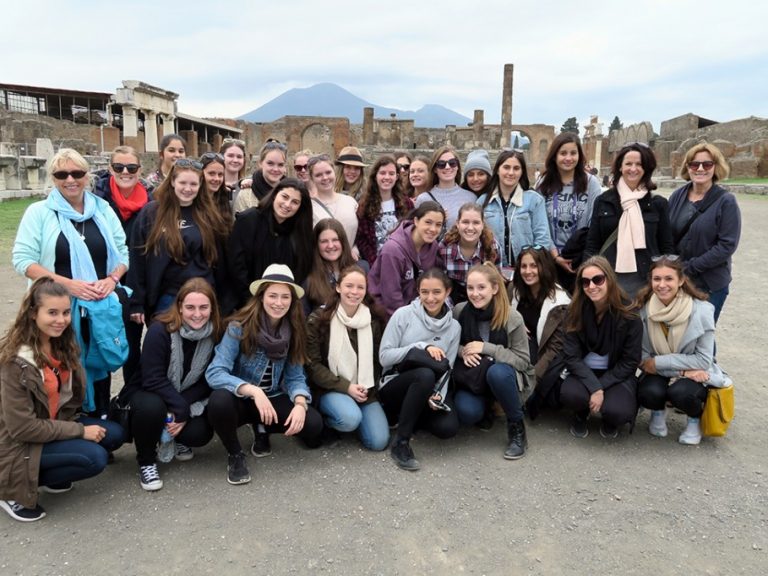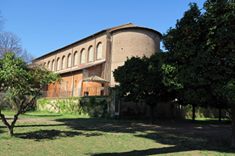From 2-18 April 2015, students studying Art and History have been given the opportunity to travel to Italy, Belgium and France to immerse themselves in European Culture.
Here are their travel reflections:
Belgium
On Tuesday we departed from Arras, France to drive to Belgium to gain a further understanding of World War One and the various perspectives and impacts the war had on individuals and communities. We visited numerous war memorials, cemeteries and also experienced the interactive museum. All these experiences were both interesting and moving, and helped to heighten our knowledge and understanding of the war.
War memorials and cemeteries provide a place for families of those lost at war to be able to visit them and pay their respects to them. For those without family in the war it provides a place of history and remembrance and as a group we were able to gain a new profound respect that we are able to take home with us.
At the beginning of the day, we went to the Battle of Fromelle cemetery, our guide Clara explained the horrific nature of the war. We learnt many details about this battle, we discovered that the battle only lasted from the 19th to the 20th of July, 1916. The specifics was particularly overwhelming as the battle only occurred to create a distraction, to draw the German soldiers away from the battle of Somme. This battle was particularly devastating as the 250 bodies of the victims were only found in 2007. This reconnected the victim’s memory with their families, as they were able to finally find comfort, knowing that their ancestors now rest in peace. This glimpse of light were only seen by some family as until present only 150 soldiers that died in the Battle of Fromelle are able to be identified.
We went to various memorials some of which that included dedications to Australian soldiers who’s actions were heroic and played an important part in saving villages in France. We visited other cemeteries that memorialised soldiers from the allied side, this was contradicted in two cemeteries that we explored as there were German soldiers that were buried within the graves. This was due to the specific rules that were outlined in the treaty of Versailles and were to be followed by Germany after the end of the war.
Hill 60 was a battlefield that shows us the nature of the German’s line, and the impact that the mine explosions and the rest of the war had on the landscape. We viewed a German bunker that survived after the war ended. We felt sympathetic towards the soldiers and the situations they were placed in, when they were located in the trenches. Clara informed us of the nature that the soldiers in both the allied and German sides had to ordeal. Although they both were basically the same, each had there differences, the allies as they were in trenches, were more prone to ‘trench foot’, however the Germans experienced famine whilst fighting in the Western Front.
Our favourite part of the day was visiting the ‘In Flanders Fields Museum’ as were able to enhance our learning by participating and interacting with the various exhibits and informative videos.
To end the day we attended the Last Post ceremony at Menin Gate where there was a memorial service that is commemorated everyday. Three people in our group (Amelia, Emily and Ms Eza-Smith) who all had relatives who fought and died in The Great War. Due to the information we learnt that day and the previous, we were able to fully appreciate the last post, as we all had gained a new understanding of the soldiers sacrifices and the importance of recognising the victims of the First World War. This enriched knowledge was only gained by seeing the mass amounts of graves and the primary sources that showed us a insight into the lives of the soldiers. Our experiences will benefit us greatly as on our return home, we will be able to provide insight of our trip to our peers. It will also allow us to appreciate the unit whilst we study it in our senior years.
Amelia, Analiese, Ellen and Natalie
Italian Artwork
As year 11’s last term we studied the Renaissance and Baroque period, in which we enhanced our knowledge of innovations and features of these specific era’s. These features of Renaissance art were clearly evident as we ventured into the Sistine chapel. Painted by Michelangelo between 1477-1480, ceiling fresco’s of the Sistine chapel depict the stories of Genesis, whilst the walls illustrate the stories of Moses and the New Testament. Idealised representations of human figures shown in the work were common in the high Renaissance era. The chapel also includes Michelangelo’s “the last judgement”, which heightens the emotions and responses to the counter reformation.
Similarly, Michelangelo’s sculpture “David” encompasses features of the high Renaissance. We visited the Galleria Dell’ Academia where we viewed Michelangelo’s original sculptures and drawings to celebrate the 4th century of the artists birth. This 5m tall sculpture, designed using contropasto pose creates a sense of strength and dominance whilst his gaze reflects the personas concentration. As students, being able to experience this sculpture in real life allowed our knowledge to be further enhanced by allowing us to view the fine details of the sculpture, especially in the hands and the veins with an incredibly realistic portrayal of the blood flow in the body.
Contrastingly, Bernini’s “The Ecstasy of St Teresa”, in Santa Maria della Vittoria, encompasses the Baroque style through the dramatic and theatrical style of the work in order to persuade people to come back to the church during the counter reformation. This baroque style was further seen in St Peters Basilica in the Vatican City, encompassing the oval piazza added by Bernini in the 17th century.
In conclusion, exposure to these masterpieces of art has allowed us as art students to enrich our understanding and strengthen our previous knowledge of these periods and the innovations developed by the artistic geniuses in these eras.
Annalise, Caitlin and Holly
Colosseum
The Colosseum was just as breathtaking as each other site, giving us an even further insight into the Romans every day life. This entertainment centre was built entirely of white limestone, being held together by small pieces of iron. These fragments of iron have since been removed in the medieval times by the Pope to build the Vatican. This particular amphitheatre/entertainment centre has a significant impact on all citizens of Rome and others beyond the boarder, as it holds so many stories and understandings into the average Roman’s life.
Santa Sabina – Rome
On Wednesday 8 April we visited our home church Santa Sabina in Rome on the Aventine Hill. It is considered to be the best example of an early Christian church and is the mother church of the Order of Preachers (Dominicans). The church is built on the site of the 4th century house of Sabina, Roman matron. Sabina was martyred in 125AD because she had been converted to Christianity by her servant Seraphia. She was later declared a saint.
Pope Honorius III approved in 1216 the Order of Preachers, now commonly known as the Dominicans, which was “the first order instituted by the church with an academic mission”. Honorius ii invited St Dominic, the founder of the Order of Preachers, to take up residence at the church of Santa Sabina in 1220. In May 1220 at Bologna, the Order’s first General Chapter mandated each convent of the Order to maintain a stadium ( place of study or school). In 1265 Thomas Aquinas was assigned as regent master at the stadium at Santa Sabina. The new stadium at Santa Sabina was to be a school for the province at which Aquinas taught the full range of philosophical subjects, both moral and natural. The stadium at Santa Sabina was the forerunner of the stadium general at Santa Maria Sopra Minerva. The latter would be transformed in the 16th Century into the College of Saint Thomas, and then in the 20th Century into the Pontifical University of Saint Thomas Aquinas (known the Angelicum).
Orange Grove
Parco Savello, the Orange Grove next to Santa Sabina, is reputed to be the location from which a cutting was taken for the orange tree now growing in the grounds of our Santa Sabina College.
Roman Forum
Visiting the incredible ancient site of the Roman Forum has made us very thankful for being brought up in the 21st century. This particular site was the centre of all religious activities, and was the most important place for any public ceremony such as speeches, meetings, parades, politic debates, or the traditional Sunday outing to church. Our amazing tour guide Paolo, who was able to keep us entertained and engaged throughout the whole tour, offered us the opportunity to become Vestal Virgins. After finding out these untouched girls were picked between the ages of 6-10 to keep the sacred fire in the temple a-light for 30 years, alongside remaining a virgin and being punished by death if the light was to ever be extinguished, we decided to turn down the delightful offer. An equivalent of $4000 monthly however, was a temptation, though through the pressure and circumstances, we remained with the satisfied agreement of a polite “No Thanks.”
Ostia Antica
On our way to Rome on Tuesday 7 April we stopped off at Ostia Antica where our guide Paolo met us. Paolo was highly informative, passionate about his ancient history and very engaging to listen to. The ancient Roman city of Ostia was in antiquity situated at the mouth of the river Tiber, some 30 kms to the west of Rome. The shoreline of the coast, due to silting over several centuries, is now 3 kms from Ostia. Ostia is Latin for “mouth”, the mouth of the Tiber. The river was used as a harbour. Ostia may have been Rome’s first colony, around 7th Century BC, but the oldest archaeological remains so far discovered date back to only 4th Century BC. The town continued to develop, reaching a peak of between 75,000-100,000 inhabitants in 2nd and 3rd centuries AD. Most of the inhabitants were working class. A slow decadence began in the late Roman era around the time of Constantine I, with the town ceasing to be an active port and instead becoming a popular country retreat for rich aristocrats from Rome. With the end of the Roman Empire, Ostia fell slowly into decay and was finally abandoned in the 9the century AD due to the repeated invasions and sackings by Arab pirates. Because the town was abandoned and not built over much of the site remains as it was in Roman times.
Herculaneum
Herculaneum, unlike Pompeii, was buried deeply enough to preserve the upper stories of buildings. It was a wealthier town than Pompeii for aristocratic families. A pyroclastic surge from the eruption of Vesuvius, formed by a mixture of ash and hot gases, billowed through the evacuated town of Herculaneum at 160 km/h where it reached the beach and the boat houses with a wave of heat of 500 degrees, killing instantly the people waiting to be rescued, carbonising organic material thus preserving skeletons.
A take away food shop ancient Roman style at Herculaneum, Naples.
Herculaneum citizens trapped in boat houses when pyroclastic surge of 500 degrees swept through at 160 km/h carbonising all material. — at Herculaneum, Naples.
Pompeii
We spent our first day in the ancient City of Pompeii. This was an incredible city that was very advanced for its time, demonstrating street systems, complex building structures and civilisation hierarchy.
Caitlin and Ellen on pedestrian crossing — in Pompeii, Italy.


















